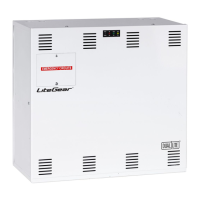
Do you have a question about the Hubbell DUAL LITE LiteGear LG Series and is the answer not in the manual?
| Input Frequency | 50/60 Hz |
|---|---|
| Enclosure Rating | NEMA 1 |
| Input Voltage | 120/277V AC |
| Emergency Lighting Time | 90 minutes |
| Frequency | 60 Hz |
| Humidity | 0% to 95% non-condensing |
| Dimensions | Varies by model |
| Weight | Varies by model |
| Certifications | UL 924 |
| Battery Type | Sealed Lead Acid (SLA) |
Basic safety precautions for electrical equipment, including handling batteries and avoiding hazards.
Instruction to retain safety guidelines for future reference.
Details on input/output voltage, frequency, surge protection, and load characteristics.
Information on battery type, charger, voltage, runtime, and operating temperature.
Procedures for inspecting cartons for shipping damage upon receipt.
Recommendations for storing units and batteries in a clean, cool, dry location.
Guidelines for installation location regarding cleanliness, temperature, humidity, and ventilation.
How operating temperature is affected by altitude above sea level.
Lists essential tools needed for mounting the inverter system cabinet.
Guidance on selecting hardware and utilizing unit knockouts for installation.
Step-by-step instructions for securely attaching the cabinet to a mounting surface.
Critical safety warnings and procedures before making AC connections to the unit.
Steps to take before connecting AC input and output wiring.
How to install jumpers to set the correct AC input voltage.
Instructions for connecting AC input and output wires to the terminal block.
Wiring diagrams illustrating different load configurations like normally-on, normally-off, and switched.
Wiring diagrams for switched or dimmable emergency loads and dimming control.
Essential safety rules for handling, connecting, and working near batteries.
Procedures for placing, installing, and wiring batteries within the unit.
How to verify correct battery voltage using a multimeter.
Initial steps for startup sequence including pre-charge and breaker settings.
Checking LED indicators after power-up to confirm system status.
How to perform a manual test on specific models by pushing the TEST switch.
Performing manual tests on SI models using specific button press patterns.
Description of automated diagnostic tests performed by the system.
Explanation of LED indications for self-test status and troubleshooting.
Critical steps to safely power down the inverter system.
Recommended periodic maintenance tasks for peak performance.
Procedures for performing monthly and annual manual inverter tests.
Information on identifying and replacing DC fuses.
Periodic checks for battery health, including visual inspection and connection tightness.
Step-by-step instructions for safely replacing batteries in the unit.
Safety and regulatory guidelines for the proper disposal of used batteries.